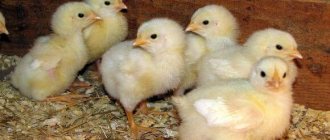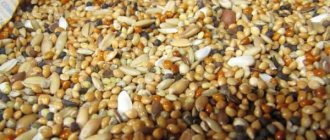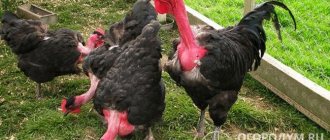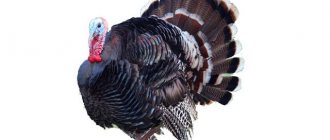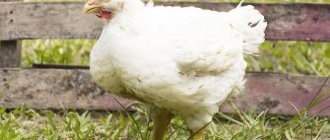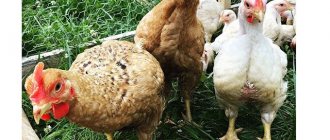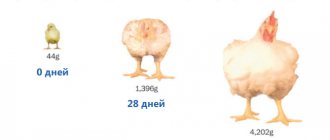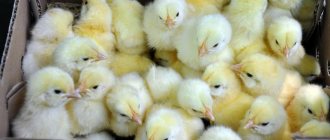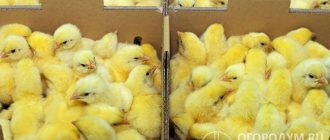Breeding chickens is a profitable business. When properly organized, it shows its effectiveness both on farms and on personal farmsteads. One of the key conditions for high profitability is a balanced and nutritious diet for birds. The health and productivity of the entire livestock directly depend on it. Depending on the size of the enterprise and the availability of your own feed supply, chickens can be given purchased or independently prepared mixtures. The main thing is to provide the chicks with enough calories and nutrients.
- Features of broiler breeds Pros and cons of broiler breeds
- Diet of broiler chickens in the first days of life
Pros and cons of broiler breeds
| Advantages | Flaws |
|
|
Description of meat breed
Broilers have their own external and physiological characteristics. However, some broiler breeds are slightly different. If you want to learn more about broilers, there are several breeds to consider.
- ROSS-308. The line is characterized by a rapid increase in muscle mass, with chickens gaining almost 60 grams per day. Birds between 6 and 9 weeks of age should be slaughtered to maintain the best meat characteristics. Weight at this age can reach 2.5 kg. A characteristic feature of ROSS-308 is good egg production, the ability to reproduce its own offspring and pale skin;
- ROSS-708. Modified crossovers with strong performance characteristics, higher than ROSS-308. In just a month of active feeding, chickens can reach 3 kg. This species is the most successful in its breeding group. It is very popular in industrial production. Too pale skin is a disadvantage, because the covers do not have time to reach a natural shade in such a short period of development. Broilers require special attention and proper care;
- Broiler - 61. High productivity with low feed consumption puts this meat breed at the forefront. To increase meat by 1 kg, only 2 kg of feed is required. After 6-7 weeks the bird weighs almost 2 kg. Chickens are hardy and survive (98%);
- COBB 500. This specimen gained its popularity due to its natural yellowish skin tone, despite the short development period before recommended slaughter. These qualities are necessary to sell meat. The rate of weight gain is high; in 40 days the chick reaches a weight of 2 kg. The maximum development period is from 40 to 42 days.
Appearance
Broilers have a large appearance with well-developed muscles. The head and neck are medium in size, but appear small in comparison to their bulky body. Broiler chickens have a wide, massive chest and a large and muscular body. The tail is short and underdeveloped. The body is supported by short legs with large feet. The feathers are white, without inclusions of other shades.
The meat breed of broilers is characterized by inactivity and phlegmatism. These people will not cause quarrels and disturbances in the poultry farm.
Conditions of detention
Despite the unpretentiousness of broilers, to increase productivity it is necessary to create a certain microclimate in the poultry house. The room should be pre-disinfected and heating devices should be installed in it during the cold season. Birds need stable, dim lighting with breaks at night, as they eat less well in the dark.
Feeders and drinkers should be placed in sufficient quantities so that chickens always have free access to them. In addition, it is necessary to maintain air humidity at 55–65% and regularly update the litter.
How to identify good quality chicken?
The issue of chick quality always causes a lot of controversy between chicken producers (hatcheries) and farmers. Everyone pursues their own goals and has their own point of view. Chick producers are concerned with achieving high hatch rates and maximum chick production. It is important for the farmer that the chickens enter the poultry house as quickly as possible after hatching, not dehydrated, and that the percentage of mortality and culling in the first week is minimal.
selection of healthy chickens
Assessment of young poultry at one day of age is an important stage in biological control. It can be carried out in different ways, the simplest is inspection. Currently, a number of criteria are used to assess the quality of young animals, which with a high degree of reliability make it possible to determine the viability and production potential of chickens. A high-quality chicken should be mobile, stand confidently on its feet, actively respond to sound, have a pronounced pecking reflex, a soft belly with a tightly closed umbilical ring; its down should be dry, well fluffed and evenly distributed throughout the body without contamination, eyes open, shiny, head, beak, joints, fingers without defects.
Requirements for arranging a chicken coop
To increase the survival rate of the population, chicks in the first days of life and grown young animals should be kept in different rooms. The hatched chicks are kept in the brooder for 10 days. It is necessary to maintain a stable temperature regime in it, ensure constant air ventilation, but avoid drafts. The placement rate does not exceed 18 chickens per 1 m². The lighting intensity in the brooder should be at least 1.8 W/m².
On day 11, the chicks are transferred to a common chicken coop. In large farms they are placed on the floor or multi-tiered racks in cages designed for a total weight of up to 40 kg. At home, the construction of complex structures is unjustified, so chickens move freely around the poultry house. It is recommended to equip the room with supply and exhaust ventilation. If you plan to breed broilers seasonally (only in spring and summer), you can place the young animals in an unheated room. When growing year-round, it is necessary to insulate the chicken coop in advance and take care of the heating system.
Productivity characteristics
The productivity of broilers is at a high level. Chickens need only 60 days to reach a slaughter weight of about 2 kg. With proper care and maintenance, the quantity and quality of meat will remain at optimal levels. Broiler breeding line plays a big role in performance. If a poultry farmer needs fast and powerful meat flow, ROSS-708 will be your best choice.
The most productive chickens are those raised in the hatchery of a specialized poultry farm. When breeding at home, some breeds may be mixed and the quality of the meat may change. It is strongly recommended not to buy broilers from the market, which can be selectively slaughtered.
Chickens up to three months of age have the best taste. After gaining weight, it is recommended to slaughter them so that these characteristics do not deteriorate. This usually occurs in the fifth month of the bird's life. One representative can weigh up to 4.5 kg.
Many owners keep broilers for a long time, just like regular layers. Hens reach sexual maturity at 6 months of age and active egg production begins. One laying hen can lay up to 20 medium-sized eggs per year.
Choosing the optimal breed
Almost all broiler crosses are the result of hybridization of highly productive meat chickens. They have a strong skeleton and in most cases white plumage. The average daily weight gain of chickens is 80 g. The most productive broiler breeds include:
- ROSS-308 and 708;
- COBB-500;
- Hubbard F-15;
- Gibro-6;
- Broiler-61.
Among owners of private farms, birds from the Smena line are very popular. When choosing a specific breed, it is recommended to focus on its productivity indicators, adaptability to the climate of your region and the cost of chickens.
Table of weight gain by day
The gain of live body weight of broilers by day depends on the breed, sex of the bird, and conditions of detention. The weight gain of hens is slower than that of roosters. The norm for daily weight gain is not less than 60 g.
On average, the weight should correspond to the following indicators:
| Age, days | Weight, grams |
| 40-45 | |
| 1 | 50-60 |
| 2 | 65-80 |
| 3 | 85-95 |
| 4 | 100-115 |
| 5 | 120-135 |
| 6 | 140-165 |
| 7 | 170-190 |
| 8 | 200-220 |
| 9 | 230-250 |
| 10 | 260-280 |
| 11 | 300-325 |
| 12 | 345-370 |
| 13 | 380-420 |
| 14 | 440-460 |
| 15 | 485-520 |
| 16 | 540-565 |
| 17 | 580-630 |
| 18 | 650-690 |
| 19 | 720-750 |
| 20 | 780-820 |
| 21 | 850-890 |
| 22 | 920-970 |
| 23 | 1 000-1 030 |
| 24 | 1 070-1 100 |
| 25 | 1 150-1 200 |
| 26 | 1 230-1 270 |
| 27 | 1 300-1 350 |
| 28 | 1 400-1 450 |
| 29 | 1 480-1 500 |
| 30 | 1 550-1 580 |
| 45 | 2 000-2 500 |
| 60 | 2 500-3 000 |
Feeding system
The productivity of broilers primarily depends on the calorie content and balance of their diet. The immunity of chicks is established in the first days of life. A nutritious diet that takes into account the age characteristics of chickens reduces the risk of the spread of coccidiosis and other infectious diseases that cause mass death of livestock. The feed must contain all the substances necessary for active growth: proteins, carbohydrates, vitamins, micro- and macroelements. Feed mixtures for broilers are prepared from products of plant and animal origin:
- grains (corn, oats, wheat, barley and their bran);
- legumes (soybean and pea meal);
- oilseeds (sunflower cake);
- vegetables (potatoes, carrots, onions, beets, pumpkins);
- herbal flour;
- eggs;
- whey;
- return;
- meat and bone, blood and fish meal;
- hydrolysis yeast.
You can prepare chicken feed yourself or buy age-appropriate formulations. The latter contain in processed form all the components necessary for broilers and are well absorbed. When preparing the food yourself, you will have to additionally enrich it with protein, vitamin and mineral supplements and coccidiostats.
Organization of feeders and drinkers
To avoid scattering and trampling of food, it is advisable to place feeders made from a profile on the outside of the cages. This way the chicks will be able to peck food by sticking their heads through the cell. At the same time, during feeding, the chickens will not interfere with each other, because each of them will have access to the feeder.
To ensure the drinking regime of broilers, it is better to use nipple drinkers. Their main advantage is that they are easy to keep perfectly clean due to the presence of a washable valve. Nipple drinking is built on the same principle as a regular washbasin. Water begins to flow after each press of the valve. The use of such a system prevents pathogenic microorganisms that can cause various diseases in broiler chickens from entering the water.
Diet of broiler chickens in the first days of life
Hatched chicks are given crushed boiled egg yolks and warm boiled water for 6–12 hours. The breaks between feedings are 3 hours. The next day, the egg can be mixed with low-fat cottage cheese in a 1:1 ratio. Starting from day 3, the following is gradually added to the mash:
- ground cooked corn, oats or wheat;
- vegetables;
- fresh herbs.
The digestive system of chickens of this age is not yet functioning well, so high fiber ingredients should not be included in their diet.
From day 5, chickens are given fat-soluble vitamins (A, E, D) and mineral supplements to prevent the development of rickets. The number of meals during this period is reduced to 6 times a day.
Growing at home
There are several options for breeding this breed under normal conditions. To do this, day-old chicks or eggs are purchased at the poultry farm, which are then laid in the hatchery.
Most farmers practice purchasing day-old birds. As a result, the costs and time for further egg rearing are reduced. Buying a hatchery is an expensive option. Some eggs may be defective, making them unable to hatch.
The main goal of raising broilers is to obtain high-quality meat. Some farms specialize in selling day-old chicks, which are always in great demand. In order for poultry to have a high yield, the quality characteristics of the parent flock are important. There must be breeding hens and roosters that are bred in a special way to produce offspring. The process is labor-intensive and expensive, and day-old broiler chicks are not cheap. The greatest danger is the unexpected death of young chicks, leading to serious losses.
The optimal ratio of hens to roosters in the parent stock is 11: 1. The number of roosters should not be changed, as this affects further fertilization.
Eggs of broiler laying hens that have just reached sexual maturity are not suitable for further laying in the hatchery. Good offspring are children aged 8 to 12 months.
Specimens intended for breeding require careful care and special care. The health of the birds must be in excellent condition.
Diet of one month old broilers
From this age, young animals are prepared for slaughter and transferred to finishing feed. The number of meals is reduced to 3 times, while simultaneously increasing the calorie content of the diet and limiting the birds' movement. Serving size increases by 20 g every 2 weeks. Feed mixtures for broilers can contain coarse grain and granulated mixtures of large fractions. The composition of the products remains the same, but the ratio of components changes. The percentage of proteins decreases, and the amount of carbohydrates increases.
2 weeks before slaughter, fish and its processed products are excluded from the chicken diet. If this is not done, the quality of the finished product will deteriorate due to an unpleasant specific odor. The last feeding is carried out 6-10 hours before slaughter. Fasting is necessary so that the food eaten has time to be digested and does not affect the taste of the meat.
The benefits of broiler chicken meat ROSS-708
Chicken meat is healthy due to its content of vitamins, minerals and protein. Chicken broths can be drunk even during a diet after surgery. And it doesn’t matter whether it’s broiler meat or regular chicken.
Broiler breed ROSS-708 is an excellent option for growing. Its meat is both healthy and soft. But if it is not possible to keep poultry at home, then you need to be careful when choosing meat.
You need to buy meat from a trusted seller, because without knowing the subtleties when choosing, you can buy a “pig in a poke.” After all, no one admits what the chickens were fed before slaughter.
In general, in order not to guess whether the meat they offer to buy is good, it is better to raise your own chickens at home.
How to properly introduce compound feed?
Broiler chickens quickly adapt to new products. Therefore, they can be given compound feed already in the first week of life. Chicks require a special pre-start composition. At first, the feed is introduced in small quantities, and by the end of the week it completely replaces the egg.
After this, the chickens are gradually transferred to starter mixtures. The majority of the diet of one-month-old broilers consists of grain-based feed. Before slaughter, the birds are transferred to a finishing feed mixture.
For breeders who combine the breeding of broilers with the cultivation of various feed crops, it is more profitable to use their own raw materials than to buy ready-made mixtures. However, in this case there is a possibility of nutritional deficiency in the chickens' diet. To compensate for it, it is advisable to use special feed additives that contain proteins, vitamins, minerals, and enzymes in concentrated form.
Errors in keeping and caring for chickens
If you use sawdust or straw as bedding, then you need to build a platform for drinking water that will not get wet. Liquid constantly splashing out onto the deep litter will cause it to become wet and it will become an ideal breeding ground for microbes and fungi.
It is recommended to change the bedding at least once a week, clean the cages and treat them with antimicrobial agents.
The diet of chickens should be varied and balanced. A monotonous menu will sooner or later lead to a lack of nutrients in the body.
How to properly keep laying hens in winter: insulation of the chicken coop, diet, lightingWhat to feed chickens: diet and types of feed from the first days to adulthood (140 photos)
Cages for broilers: dimensions, drawings, description of materials and photos of DIY construction
Broilers must be fed at the same time every day. Day-old chicks feed around the clock in the light.
If there is a risk of contracting an infectious disease, then young animals can be vaccinated, especially if broilers and laying hens are kept together.
Looking at the photo of broiler chickens, you can note that these birds are quite massive. Keeping them in the household will provide its owners with tasty meat, suitable for any type of cooking - boiling, frying, stewing, etc.
Keeping Birds Healthy
To prevent rickets, coccidiosis and other dangerous diseases, vitamin and mineral supplements and coccidiostats are included in the diet of growing chickens. To reduce the risk of the spread of intestinal disorders, it is important to keep feeders and drinkers clean. Additionally, it is recommended to feed the chicks from days 5 to 7 with a weak solution of potassium permanganate.
Sick chickens are quarantined so that they do not come into contact with healthy individuals. Pharmaceuticals, including antibiotics, should only be given after consultation with a veterinarian. They are not used at the final stage of fattening to prevent medications from getting into the meat.
Due to the sudden weight gain in broilers, the load on the skeleton increases greatly, so they need more vitamins and minerals. You can introduce each component separately or use complex supplements that include the required set of biologically active substances (BAS).
Visual assessment of chicken quality
Choosing strong young animals based on external characteristics will increase the survival rate of chicks and will allow you to more effectively run a broiler breeding business.
Therefore, before choosing broiler chickens when buying, you need to pay attention to the following signs:
1. Activity and mobility.
Activity is checked by turning the chicken on its back. An active chicken will strive to return to its original vertical position and stand on its feet as quickly as possible. It takes him less than 2-3 seconds to do this. A weak chicken will either take much longer to get to its feet or will not be able to get up at all. As a rule, once in the poultry house, weak chickens die within the first week, as they cannot reach water or feed.
If the chick does not stand well on its legs, falls or sits in one place, then this is a sign that it is weak and will most likely die soon. It is also a bad sign if the chick sways or lies down all the time. Healthy chickens are very active and mobile, they stand confidently on their feet. Often the reason for the low mobility of birds is that the conditions at the hatchery were not optimal: high humidity, low temperature, etc. All this will negatively affect the further development of the bird.
2. Clean cloaca and well-formed umbilical ring.
Choosing healthy chickens
The umbilical ring should be tightly closed, dry, without sticking of shells or egg membrane residues. Upon examination there should be no traces of bleeding from it.
An umbilical ring that is not tightly closed serves as a gateway for infection into the body. Such chickens have low viability and should be culled from the flock.
3. Abdominal examination.
The belly of day-old chicks should be soft and smooth. Bloating, hardness, or tension in the abdominal wall indicates poor absorption of the yolk. The reasons are most often associated with a violation of the incubation process (too high temperature, insufficient moisture loss). Very often, a hard belly is associated with an infection of the yolk sac.
chick selection: belly inspection
4. Beak and joints
Damaged chick beaks and joints indicate suboptimal conditions in the hatcher. Red dots on the beak indicate that the temperature in the hatcher was too high. The chickens wanted to get out of the egg faster, damaging their beak in the process; or tried to breathe through the holes in the hatch tray, resulting in injury to the upper part of the beak.
chick selection: inspection of beak and joints
5. Clear eyes.
They should be alive and shiny. The presence of plaque is a sign of an infection that a young body cannot cope with.
6. Down color
Choosing broiler chickens
The absence of traces of blood or droppings, traces of yolk and shell is a sign that the chick is healthy. He should look fit. Faded, sparse, stray fluff is an indicator of substandard condition.
7. Position of the wings relative to the body. When at rest, they should fit snugly to the body, and not sag or protrude to the sides.
8. Reaction to sound. If you knock on the side of a cardboard box in which chicks are usually transported, the chicks should immediately respond to the sound. This is a sign that the chicks are developing correctly.
Chicks should be no more than 12-24 hours old after hatching. Inspection is a simple and fairly quick way to cull chicks. If this is not done, then weak individuals will die soon, and this is a loss for the enterprise. There is no point in wasting money, labor, feed, or water on substandard birds. In addition, weak chickens can be carriers of various diseases, including infectious ones, which quickly spread in the flock. Their timely culling is a way to prevent the death of the rest of the young.
The best option for purchasing chickens is to buy them from a hatchery station, since such farms are attentive to raising young animals. But even this approach does not exclude the need for visual monitoring of chicks.
Mistakes of novice breeders
Although raising broilers does not present any particular difficulties, inexperienced owners do not always provide the chickens with normal living conditions. This leads to a decrease in productivity, and in some cases, to the death of birds. Common mistakes include:
| Failure to comply with temperature conditions | In an insufficiently warm room, chickens' immunity decreases. Exceeding the temperature norm causes lethargy and loss of appetite in birds. |
| Excessive humidity | Leads to the appearance of fungus and promotes the spread of pathogenic microorganisms. |
| Insufficient hygiene | Dirty feeders and bedding cause intestinal infections and intoxication with ammonia compounds. |
| Ignoring veterinarian recommendations | Saving on veterinary care can lead to significantly greater financial losses in the event of late or incorrectly selected treatment. |
Diseases
Most often, in order to protect chickens from diseases, it is enough just to maintain optimal housing conditions. The main method of preventing various diseases is proper and balanced nutrition.
But no matter how hard the owners try to care for the bird, there are times when they get sick. How to treat broiler chickens? Treatment should depend on the etiology of the disease and should be prescribed exclusively by a specialist.
In the case of infectious intestinal diseases, which are most common among chickens, veterinarians most often prescribe antibacterial drugs. They can be purchased at any veterinary pharmacy.
It must be remembered that infected birds must be isolated from healthy ones. This will help prevent other chickens from pecking at it and infecting healthy broilers.
Useful tips from
There are various techniques for stimulating appetite in broilers:
- As the chicks grow, the size of the feeder should increase. It is optimal if the height corresponds to the level of the chickens’ backs. The container must be made of durable food-grade plastic that can be washed with disinfectant solutions.
- The amount of food for each meal is calculated taking into account the rate of consumption of the previous portion. If it is less than half an hour, the volume of the mixture is increased. If the birds do not have time to eat the food in 45 minutes. and more, the portion needs to be reduced.
- It is better to give granular formulations to chickens from one month of age. They are more hygienic and better digestible because the bird cannot choose the tasty bits from them.
- The optimal mode of alternating light and darkness for broilers is 4/2 hours. In this case, they eat more and gain weight faster.
- On a large farm, it is convenient to use automatic feeding systems, in which food is supplied through a conveyor at certain intervals.
Purchased feed has a number of advantages over self-prepared mixtures. Large manufacturers are responsible for the quality of their products. Their feed complies with GOST and has been certified. A large number of ingredients in the mixtures make it possible to fully meet the nutritional needs of broilers.
In our company you can order compound feed and BVMD for meat chickens of any age. We produce:
- starting compositions for 0-2 and 3-4 weeks;
- and finishing feeds for chickens from 5 weeks and older.
High quality of incoming raw materials, accurate dosage and high-quality mixing of components make our products useful and safe.
Features of broilers and rules for acquiring a “meat” herd
Sometimes “broiler” refers to any variety of chicken that can quickly gain slaughter weight, but this is not entirely correct. In scientific animal husbandry, broilers are considered to be hybrid farm birds or animals (for example, rabbits) bred by crossing two or more closely related breed lines. As a result of such selection, individuals with a very specific metabolism are obtained. They effectively absorb feed, quickly build muscle mass and produce high-quality meat products.
The owner of an individual plot who intends to raise chickens “for meat” must first of all solve the problem of acquiring young stock of the selected cross. This can be done in one of two ways: purchase chickens or raise them on your own farm. Each option has its positive and negative sides, which are worth considering in more detail.
All issues related to raising chickens in an incubator are discussed in detail in the article on our website
Self-breeding is good because the babies will immediately find themselves “at home” and will not be subjected to stress associated with transportation, to which babies are very sensitive. In addition, the owner will monitor their condition, starting from the embryonic stage, responding to problems in a timely manner and culling “substandard” individuals. Another “advantage” is the fact that hatching eggs usually cost significantly less than live young eggs. On the other hand, raising chickens on your own farm requires not only a household incubator (or chickens with well-developed maternal instincts), but also a certain amount of poultry farming experience for the owner of the farmstead.
For the most inexperienced owners in this sense, the option of buying chickens is better suited. We advise beginning poultry keepers to purchase older chicks rather than one-day-old babies. This will require more significant investments, but will help to avoid mistakes associated with “re-grading,” that is, cases when they try to sell young animals of other crosses and breeds under the guise of broilers.
It is recommended to buy young animals from large poultry farms, which guarantee that the selected cross meets the stated characteristics.
At 5-6 days, chickens should have the following characteristics:
- body weight of at least 100-115 g (young laying hens at this age are almost twice as light);
- wide (almost “rectangular”) body;
- muscular chest and tight thighs;
- slightly shortened, plump paws with a wide, massive metatarsus;
- a large head, not quite proportional to the body;
- calm, sometimes even phlegmatic character;
- excellent appetite.
Broiler chickens acquire sexual differences very late. However, the future owner should not be interested in the number of males and females in the acquired herd, since they were not initially intended for breeding. The bird of the most common crosses has pure white plumage, although there are also “colored” varieties. In any case, you should not choose chicks from a flock in which there are both white and spotted individuals, as this may indicate the seller’s dishonesty.
The plumage color of most broiler chicken varieties is pure white.
It is necessary to purchase hatching eggs or young broilers from the most reputable breeders. Large poultry farms engaged in the industrial production of poultry meat are best suited for this purpose. As a rule, they can provide the buyer with all the necessary documents and recommendations on maintenance and feeding, and also guarantee that the “product” belongs to a specific cross. In addition, contacting such a seller allows you to buy chickens whose health has been professionally monitored from the moment they were born, fed correctly and even given the age-appropriate vaccinations, which is an additional “plus”.
Care instructions
A broiler chicken requires more careful care than a regular laying hen. A warm poultry house and a clear daylight regime are important.
The room is washed and whitened, drinking bowls and feeders are installed, lighting and heating are provided, and a thermometer is installed. A blanket of sawdust is placed on the floor.
For the first 2 weeks, round-the-clock lighting and a temperature of + 30 degrees should be provided. Subsequently, reduce the temperature by 2 degrees per week to +22 °C.
When the broilers are 1 month old, the daylight hours should be 14 hours, and the lighting should be turned off for 10 hours.
There should be no more than 13 heads per 1 m2. If the livestock is larger, the barn should be equipped with cages.
On a note . The floor in the chicken coop should always be dry and clean. Humidity can make the bird sick.
Broiler incubation mode
Before laying, eggs are disinfected using a solution of potassium permanganate or hydrogen peroxide. They are allowed to dry by laying them on a clean cloth - do not rub the surface. The incubation material should be at room temperature. Before laying, the incubator is warmed up, simultaneously checking its performance.
The incubation mode is designed for 21 days. The first 3 days maintain the highest temperature – +38°C with a humidity level of 60%. Then:
- until the 10th day, set the temperature to +37.8°C;
- before the 15th – +37.6°С;
- before the 17th – +37.4°С;
- before the 18th – +37.2°С;
- until the 21st – +37°С.
Humidity level:
- from the 4th to the 18th day inclusive – 55%;
- from the 19th to the 21st day – 65-70%.
Turn the eggs at intervals of 1-1.5 hours until the 19th day. They are cooled starting from the 5th day (1-2 sessions of 15-20 minutes each). No refrigeration is required for the last 3 days.
Business plan for breeding broiler chickens
Having decided to raise broilers as a profit-generating activity, the entrepreneur must develop a detailed business plan.
The initial investment includes the following expense items:
- registration of activities, obtaining permits - about 20,000 rubles;
- purchase of chicks: the cost of one chicken is from 40 rubles;
- purchase of the first batch of feed - about 50,000 rubles;
- chicken coop equipment (including feeders, drinking bowls) - about 200,000 rubles;
- installation of ventilation and lighting systems - about 100,000 rubles.
If you do not have your own premises, you need to add the costs of purchasing or renting it to this list. The cost of finished poultry houses designed for 1000 birds (“turnkey”) will be about 1,500,000 rubles.
You also need to pay attention to your monthly expenses. This list includes the following items:
- maintenance – about 20,000 rubles;
- utility bills - about 15,000 rubles;
- purchase of feed – 50,000 rubles;
- purchase of consumables, bedding – 10,000 rubles;
- registration of veterinary certificates and certificates – 5,000 rubles;
- transportation costs – 10,000 rubles.
In addition, funds are needed to pay salaries to employees and pay taxes.
The profitability of this type of business will be 30%. Payback period is from 12 to 14 months.
An entrepreneur has several distribution channels. This:
- point on the market;
- supply to retail chains;
- sales through an online store;
- supply to catering establishments.
As production develops, related products appear that increase profits. These are not only poultry carcasses, but also feathers, down, bird droppings for fertilizers, eggshells and waste from cutting carcasses for feed production.
You can also sell day-old and grown-up chicks to private individuals.
Another option for doing business is purchasing an incubator and eggs. In this case, one-day-old chicks can be bred for sale.
Watch a video about the features of raising broiler chickens for sale:
Broiler chickens gain weight quickly. They are ready for slaughter at 40-50 days. They have large breasts and powerful legs, so breeding these birds is profitable from an economic point of view. The business will be profitable provided that the birds are properly cared for and maintained.
0
0
Copy link
When to cut broilers?
When broilers grow up and gain the required weight, it is not advisable to keep them any longer, since after two months of age broilers gain weight more slowly. In our first experience of breeding broilers, we only parted with cockerels. Chickens at the age of 5 months began to lay eggs (the breed was meat-egg). This continued until mid-November. We gave the laying hens to a good friend for the winter, and the following spring we took them back again. These birds supplied our family with eggs throughout the next summer. But that's a completely different story.
But broiler meat needs to be plucked after slaughter. To do this, the carcasses are placed in hot water at a temperature of +50°C. Then the feather is easier to separate. But you should not cook such a bird right away, as it will be tough. We need to freeze it. You will be able to enjoy healthy meat no earlier than in a day.
Dear readers! There are many advantages to breeding crosses. In two summer months, you will be able to raise a bird that will provide your family with meat, the quality of which you will not doubt. You can also raise broilers for sale, as it is profitable. After all, 1 kg of such homemade meat today costs 250 rubles.
